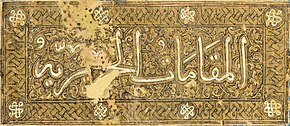

The Maqāmāt al-Ḥarīrī (Arabic: مقامات الحريري) is a collection of fifty tales or maqāmāt written at the end of the 11th or the beginning of the 12th century by al-Ḥarīrī of Basra (1054–1122), a poet and government official of the Seljuk Empire.[3] The text presents a series of tales regarding the adventures of the fictional character Abū Zayd of Saruj who travels and deceives those around him with his skill in the Arabic language to earn rewards.[4] Although probably less creative than the work of its precursor, Maqāmāt al-Hamadhānī (whose author lived 968–1008 CE), the Maqāmāt al-Ḥarīrī became extremely popular, with reports of seven hundred copies authorized by al-Ḥarīrī during his lifetime.[5]
The first known manuscripts date from the 13th century, with eight illustrated manuscripts known from this period. The most famous manuscripts include one from 1237 in Baghdad (now in the Bibliothèque Nationale de France) and one from 1334 in Egypt or Syria (now in the National Library of Austria).[6]
Altogether, more than a hundred manuscripts of the work are known, but only thirteen are illustrated. They were mainly produced over a period of about 150 years.[7] A first phase consists in manuscripts created between 1200 and 1256 in areas between Syria and Iraq. This phase is followed by a 50-year gap, corresponding to the Mongol invasions (invasion of Persia and Mesopotamia, with the Siege of Baghdad in 1258, and the invasion of the Levant). A second phase runs from around 1300 to 1337, during the Egyptian Mamluk period, with production probably centered around Cairo.[8]
Manuscripts of the Maqāmāt al-Ḥarīrī belong to the category of "secular Arabic manuscripts", as opposed to religious works such as illustrated Qur'ans.[9]
- ^ Hillenbrand 2010, p. 118.
- ^ Ḥarīrī al-Baṣrī, Muḥammad al-Qāsim ibn ʿAlī al- (1054-1122); texte, Al-QĀSIM ibn ʿAlī al-Ḥarīrī (Abū Muḥammad) Auteur du (1201–1300). "Les Maqâmât d'Aboû Moḥammad al-Qâsim ibn ʿAlî al-Ḥarîrî".
{{cite web}}: CS1 maint: numeric names: authors list (link) - ^ Flood, Finbarr Barry (2017). "A Turk in the Dukhang? Comparative Perspectives on Elite Dress in Medieval Ladakh and the Caucasus". Interaction in the Himalayas and Central Asia. Austrian Academy of Science Press: 232.
- ^ "Al Maqamat: Beautifully Illustrated Arabic Literary Tradition – 1001 Inventions". Retrieved 2023-07-28.
- ^ George, Alain (February 2012). "Orality, Writing and the Image in the Maqamat : Arabic Illustrated Books in Context". Art History. 35 (1): 10–37. doi:10.1111/j.1467-8365.2011.00881.x.
Originality and realism were clearly not among the aims of their author, which has led some modern scholars to rate his work as inferior to that of the founder of the genre, al-Hamadhani (968–1008 CE). Yet this perception was not shared by Arabic-speaking audiences of the twelfth century onwards, amongst whom al-Hariri's Maqamat almost immediately became a classic, soon eclipsing earlier writings of the same genre and spawning emulations in Hebrew, Syriac and Persian. So considerable was their popularity that, according to an anecdote cited by Yaqut al-Rumi (c. 1179–1229), al-Hariri had authorized seven hundred copies of the text in his lifetime.
- ^ Hillenbrand 2010, p. 119.
- ^ Grabar 1984, p. 7.
- ^ Grabar 1984, p. 17.
- ^ Snelders 2010, p. 2, ..."contemporary illustrated Islamic manuscripts, which are often also referred to as ‘secular Arabic manuscripts’ when religious works such as illuminated Qur’ans are excluded from the equation".
